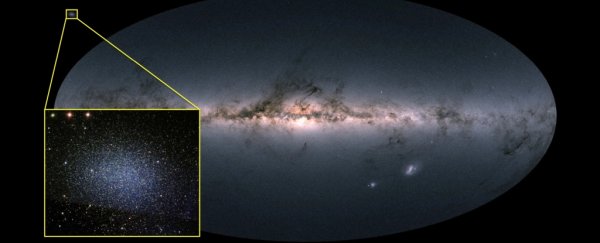A tiny galaxy orbiting the Milky Way called Leo I could be harboring a huge secret.
According to a new analysis, the central region of Leo I has an absolutely monster supermassive black hole, compared to the mass of the galaxy. The galaxy itself is around 20 million times the mass of the Sun. The black hole is around 3.3 million solar masses – around 16 percent of the total mass of the galaxy.
Although there's a large uncertainty margin, the result is still a huge surprise. That mass of 3.3 million solar masses is pretty danged close to the mass of Sagittarius A*, the supermassive black hole at the heart of the Milky Way. Sgr A* is around 4 million solar masses – and recent calculations put the mass of the Milky Way at around 1.3 trillion solar masses.
That's an absolutely gobsmacking difference in the mass ratios. The possible presence of such a large black hole in such a small galaxy is surprising since we thought we had some pretty reliable rules for the ratio of a central black hole to its galaxy. But, if verified, it could tell us something new about how galaxies, and the supermassive black holes at their centers, grow and evolve.
"A black hole mass this large in Leo I is significant in many respects," the researchers wrote in their paper.
"It is the first detection of a black hole in a dwarf spheroidal galaxy using spatially resolved kinematics, it has a mass that is similar to the total stellar mass of the system, and it is a comparable mass to that of the black hole in the center of the Milky Way."
There's a whole swarm of dwarf galaxies in the space around the Milky Way (and around other galaxies, too), some that are in the process of colliding with and being absorbed by the other galaxy. This is thought to be an important means whereby galaxies grow larger gradually over time.
But not all dwarf galaxies are built alike, and studying them can help us understand galactic diversity, and how these objects form.
Leo I, located around 820,000 light-years from Earth, is one such potential outlier. Unlike most of the Milky Way satellites, it's been found to have not much dark matter – the directly undetectable gravitational glue that binds the Universe.
Although we can't probe dark matter directly, we can measure it based on the influence it has on things we can detect. Stars, for example, orbit their galaxies faster than they should if just the detectable matter was influencing them.
Astronomers at the University of Texas at Austin's McDonald Observatory wanted to study Leo I's dark matter profile, or the way the dark matter density changes from the center of the galaxy to its outskirts.
They took new observations of Leo I using the Harlan J. Smith Telescope at McDonald Observatory, and then entered this data and sophisticated models of the galaxy into a supercomputer for analysis. And their results showed that a supermassive black hole should be lurking in the galactic center.
"The models are screaming that you need a black hole at the center; you don't really need a lot of dark matter," said astronomer Karl Gebhardt of UT Austin.
"You have a very small galaxy that is falling into the Milky Way, and its black hole is about as massive as the Milky Way's. The mass ratio is absolutely huge. The Milky Way is dominant; the Leo I black hole is almost comparable."
The team's paper showed that previous measurements of the orbital velocities of stars in Leo I showed a strong bias towards slower stars; that's why previous calculations may have missed such a huge mass. Since the new study claims not to have such a bias, it was able to find what others missed.
But the result is not entirely unprecedented, either.
In 2014, a dwarf galaxy with a total mass of 140 million solar masses was found to have a supermassive block hole clocking in at 21 million solar masses – around 15 percent of the total galactic mass. Then, in 2017, two more dwarf galaxies were found with black hole chonks, of 4.4 million and 5.8 million solar masses – 13 and 18 percent of the masses of their host galaxies, respectively.
So, while we currently have "no explanation for this kind of black hole in dwarf spheroidal galaxies," according to UT Austin astronomer María José Bustamante, perhaps it's actually quite a common occurrence.
And that could help explain how supermassive black holes get so supermassive. When two galaxies merge, eventually their supermassive black holes should, too. Which means dwarf galaxies could be feeding the black holes of huge ones.
"If the mass of Leo I's black hole is high, that may explain how black holes grow in massive galaxies," Gebhardt said.
The research has been published in The Astrophysical Journal.
